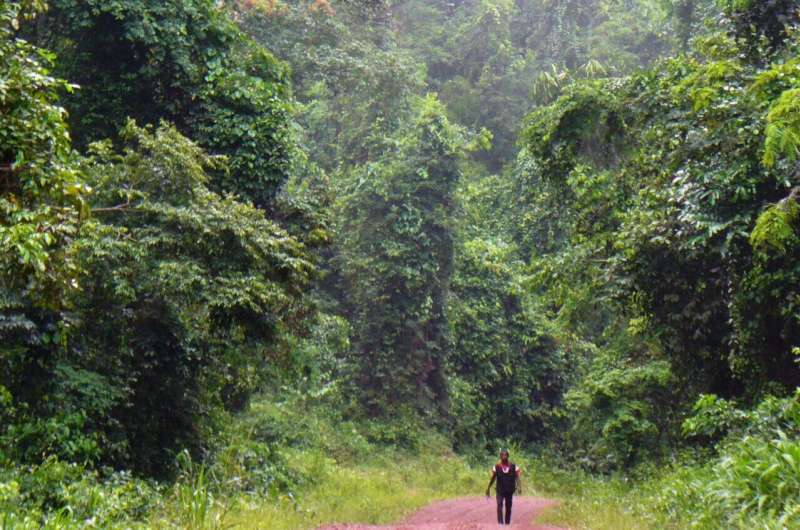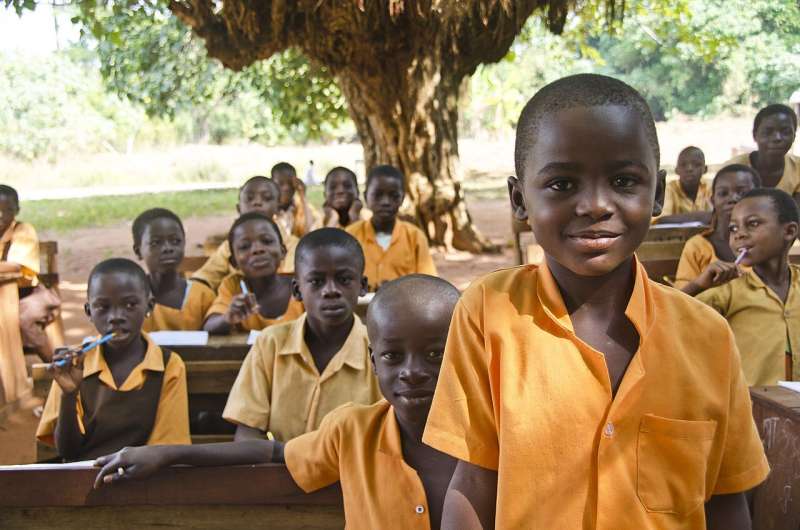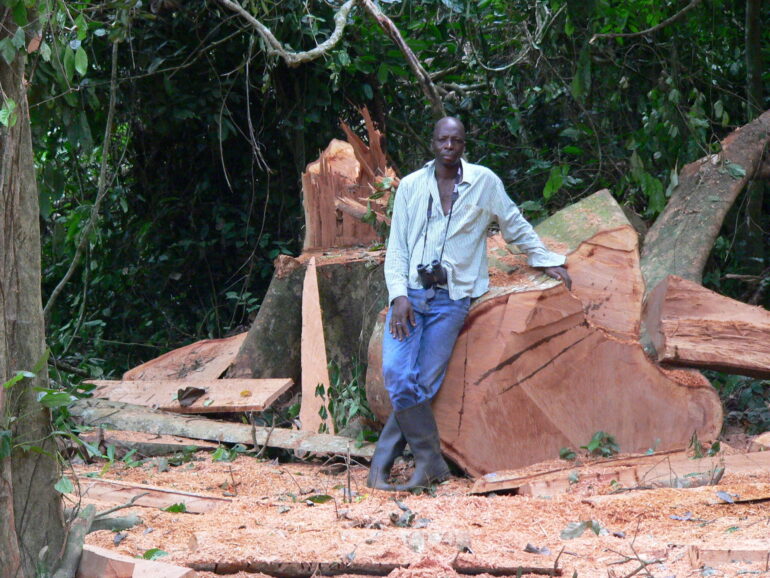Famous for its iconic wildlife, Africa is home to nature and cultures that can be found nowhere else on Earth. Unfortunately, however, this precious natural and cultural heritage is threatened by unprecedented population growth that has driven the colonization and exploitation of formerly sparsely populated or uninhabited natural areas, particularly in West Africa.
Despite decades of major investments in conservation-related foreign development aid, West Africa’s majestic rainforests and savannas have increasingly been converted to plantation agriculture and pasture, and steep losses in wildlife include 85% declines in mammal abundance, even inside protected areas.
In Ghana, for example, logging to export timber, mining for gold and other precious metals, and the replacement of rainforests with cocoa (Theobroma cacao) plantations to supply the global chocolate industry have driven the destruction of >80% of its Upper Guinea forests, although they constitute a critical global priority biodiversity hotspot.
In regions with high human population densities such as West Africa, protected areas may host the only remaining intact natural ecosystems, but their natural resources are being ever more diminished due to inadequate law enforcement and corruption.
Nature conservation efforts are essential to maintaining protected areas, mitigating wildlife declines, and realizing the United Nations’ sustainable development goals. However, evaluations of the effectiveness of conservation strategies are rare, and conservation success stories even rarer.
For example, community-based natural resource management (CBNRM) has been encouraged and supported worldwide for over 40 years, but its success remains the subject of debate. In Ghana, CBNRM has been implemented for more than 20 years in the form of Community Resource Management Areas (CREMAs).
CREMAs have recently been endorsed by the government of Ghana for sustainable forest management and reducing emissions from deforestation and forest degradation (REDD+). But how do community participants view them?
To answer this question, colleagues in Ghana and I evaluated participant views of conservation, economic, and sociocultural outcomes through 881 interviews with people in 89 communities associated with eight CREMAs in the vicinity of protected areas, including Mole National Park and Bia National Park. Ghana has over 70 indigenous languages, and interviews were conducted through consultations with native speakers.
The results are the focus of a new publication in Current Research in Environmental Sustainability made possible by the IUCN National Committee of the Netherlands in collaboration with Tropenbos International, A Rocha Ghana, and Tropenbos Ghana.
We found that although communities realized substantial benefits from participation, CREMA performance failed to meet expectations for all 33 outcomes evaluated. CREMA participants ranked increased conservation awareness as both the most important and best-performing conservation outcome, while reducing bushfires ranked second both in importance and performance.
On the other hand, CREMA participants expressed disappointment with conservation outcomes, including reducing illegal logging, which depends on government effectiveness in law enforcement.

A man walks through Boin River Forest Reserve, Ghana, a remnant of Upper Guinea rainforest where the Aowin CREMA serves as a buffer area. © Nico Arcilla
Notably, this and many of the other outcomes in which CREMA participants expressed most dissatisfaction rely on external actors and were thus beyond the scope of communities to control. A major driver of habitat destruction worldwide, illegal logging accounts for 50%–90% of timber harvested in many tropical countries, and is associated with significant wildlife declines.
Although a global phenomenon, illegal logging is particularly well-studied in Ghana, where it accounts for an estimated 80% of the country’s timber harvest. Private illegal logging networks supply most of the country’s domestic timber demand, accounting for an estimated two-thirds of Ghana’s illegal timber, and such networks are pervasive in Ghana’s remaining forests and woodlands.
Participants’ dissatisfaction with ongoing illegal logging thus reflects a wider, longstanding problem that poses a grave threat to Ghana’s biodiversity and development.
Although prior research has suggested that many CREMA participants have a utilitarian attitude toward nature rather than a conservation ethic, our data show that overall, CREMA constituents ranked conservation outcomes as more important than economic outcomes.
CREMA participant expectations were highest for conservation outcomes, such as increased conservation awareness and reduced illegal logging, second highest for economic outcomes such as increased food production and more alternative livelihood options (i.e., honey production), and lowest for sociocultural outcomes, such as collective community action and educational scholarship.
Performance gaps were most pronounced for conservation, economic, and all outcomes combined, but were insignificant for sociocultural outcomes.
Participants reported that on average, outcomes fulfilled ∼87% of their expectations, indicating that CREMA communities realized substantial benefits. Nevertheless, participants expressed some degree of disappointment with all CREMA outcomes, and we found evidence of significant performance gaps that can be taken to guide ongoing future research and conservation efforts.
Participants’ highest expectations and best perceived performance among economic outcomes included better farmland and increased food and honey production, while the largest performance gaps reported by participants included access to financial assistance, increased employment, and increased income generation.
Participants ranked sociocultural outcomes lowest in terms of expectations, but highest in terms of performance. Participants reported highest expectations and perceived performance for collective community action and traditional medicines, whereas the largest performance gap reported was for children’s school attendance.

Improving children’s school attendance was the outcome with the greatest performance gap reported by participants in community-based natural resource management projects in Ghana. © Public Domain—by A. Kauffeld from USAID in Africa—https://commons.wikimedia.org/w/index.php?curid=48378690
Our findings highlight that although CBNRM projects can play important supporting roles in conservation, such as through raising conservation awareness and providing buffers to protected areas, they are limited by design. CBNRM relies strongly on external support, such as effective law enforcement and ongoing investments, to succeed.
Successful CBNRM cannot independently achieve conservation goals, but may complement, rather than replace, long-standing conservation strategies such as effective law enforcement and well-managed protected areas. However, for CBNRM to realize its potential to contribute to conservation and sustainable development goals, government agencies and other organizations must honor their commitments to provide ongoing support and investments.
Priority areas on which to focus such efforts include increased operational budgets and capacity building for protected areas with which CREMAs are associated; hiring community members as park rangers and extension agents, for example, would contribute to closing CREMA performance gaps for increased employment and income generation.
We also recommend that future studies gather empirical data to compare with participant assessments. Quantifying changes in wildlife and natural resources in CREMAs to independently assess their conservation status over time will be essential to measure their ultimate success.
This story is part of Science X Dialog, where researchers can report findings from their published research articles. Visit this page for information about Science X Dialog and how to participate.
More information:
Andrew Kyei Agyare et al, Great expectations, not-so-great performance: Participant views of community-based natural resource management in Ghana, West Africa, Current Research in Environmental Sustainability (2024). DOI: 10.1016/j.crsust.2024.100251
Nico Arcilla is an affiliate fellow at the University of Nebraska-Lincoln and the president of the International Bird Conservation Partnership, whose mission is to foster and support research, outreach, and partnerships to advance the conservation of birds worldwide. She earned her BA at Yale University, MS at Cornell University, and PhD at the University of Georgia, USA.
Citation:
Study offers participant views of community-based natural resource management in Ghana (2024, October 9)


